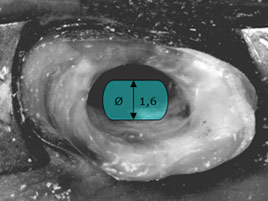Polygon Over Post
Zirconia Glass Fiber Post
Polygon Over Post are glass fiber posts with non-circular section.
As Overfibers post surfaces are particularly rough the silanization treatments are an optional.
Clinical Directions
Polygon Over Post are the first glass fiber posts with non-circular section present on the market. This characteristic, made possible by particular processing systems, which are part of the advanced Overfibers Know How.
They respects the morphology of the majority of the canals of single root teeth, adapting itself to the internal anatomy of the tooth canal (see photos A and B) with minimal removal of dental matter and maximum resistant section of the post.
They are recommended for very stressed teeth, such as abutments of extended fixed prostheses or in partially removable combined prosthetic anchor teeth (removable prostheses). Particularly recommended for single root premolars, canine teeth and incisors.

A - Standard post section

B - Polygon Over Post section
In non-circular and oval canals, compared to the common circular section (A), the Polygon Over Post offers a resistant section which is almost double (B).
Note how the diameter Ø is the same in the two posts. A: Standard posts with circular section overlapped at the root canal entrance of a lower premolar;
B: Polygon Over Posts with non-circular section overlapping the same tooth: the resistant section (light blue area) is almost double that of the previous one, and is capable of bringing a much higher level of resistance to the restoration.

Code: SKPYOP
Content:
- 3 Unit – Polygon Over Post # 1
- 3 Unit – Polygon Over Post # 2
- 3 Unit – Polygon Over Post # 3
- 1 Polygon Drill # 1
- 1 Polygon Drill # 2
- 1 Polygon Drill # 3

Code: PYOP01
Content: 10 Unit – Polygon Over Post # 1
Code: PYOP02
Content: 10 Unit – Polygon Over Post # 2
Code: PYOP03
Content: 10 Unit – Polygon Over Post # 3

Code: PYD01
Content: 1 Polygon Drill # 1
Code: PYD02
Content: 1 Polygon Drill # 2
Code: PYD03
Content: 1 Polygon Drill # 3
| Features | Advantages |
| Highly retentive surface | Increases the post / cement adhesion without weakening it with deep grooves |
| Zirconia glass fiber 80% | high flexure strength 1500 MPa |
| Balanced flexure E-modulus | 60 GPa to better stabilize the restoration |
| Translucent | to accelerate the activation of dual cements |
| Radiopacity | 3.0 mm or 300% Al equivalent |
| Fatigue Strength | 5 Millions Cycles Without Breaking |
| Sterilization in autoclave | 135°C at 2.1 bar for 5 min without any variation of their resistance |
| Non-circular section | 49% more resistant than teeth restored with standard circular ones |
Polygon Over Post and Polygon Drill are available in three sizes, with color coding for a corresponding use.
| Color | Code | Maximum diameter | Minimum diameter | Point diameter | Total length | Drill |
|---|---|---|---|---|---|---|
| PYOP01 | 2.00 | 1.20 | 0.80 | 19 | PYD01 | |
| PYOP02 | 2.20 | 1.40 | 1.10 | 19 | PYD02 | |
| PYOP03 | 2.50 | 1.60 | 1.20 | 19 | PYD03 |
- Fiber Post Bonding Using Self-Etching and Resin Cements
S. PALLOTTINI, A. LLUKACEJ, C. MONACO, and P. BALDISSARA, University of Bologna, Bologna, Italy - Fiber Post Removal: Comparative Study Using a New Post Concept
P. BALDISSARA1, D. MELILLI2, L. CIOCCA1, and L.F. VALANDRO3, 1University of Bologna, Bologna, Italy, 2University of Palermo, Palermo, Italy, 3Federal University of Santa Maria, Santa Maria, Brazil - Effect of Sterilization on Fiber Posts Fracture Strength
G. IORIZZO, S. BETAZZONI, L. CIOCCA, and P. BALDISSARA, University of Bologna, Bologna, Italy - Microtensile bond strength of fiber post: effect of surface roughness
P. BALDISSARA1*, C. MONACO1, L.F. VALANDRO2, University of Bologna, Bologna, Italy1 and Federal University of Santa Maria, Brazil2

